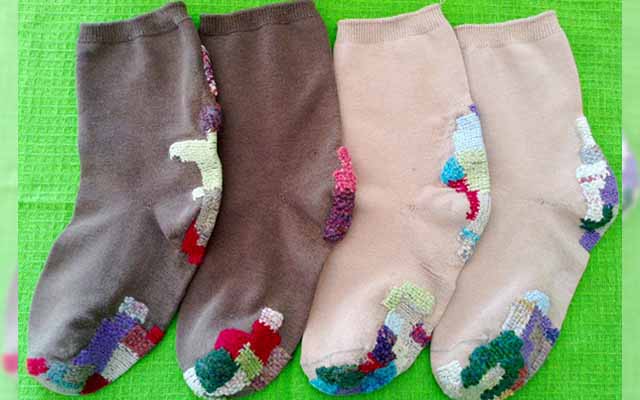- Source:
- @basilsauce
Related Article
-

You Can’t Get Any Freaking Happier Than This Shiba Inu In A Swing
-

Chocolate Mint Montblanc and more make debut at Montblanc speciality store Kurinohana
-

Kyoto Cafe Offers Healthy Vegan And Vegetarian Dishes Using Ingredients Straight From The Farm
-

Japanese cat lover mortified by his wife’s dinner plans
-

Cars Utilize Light Trajectory To Recreate Modernized Version Of Traditional Japanese Painting
-

McDonald’s New Menu Includes Matcha McFlurries And Hokkaido Milk Pies



I’m sure we’re all grateful for socks for always keeping our feet warm and toasty, but doesn’t it suck when you suddenly realize that your favorite pair has actually become hole-ridden and highly unfashionable? Well, after you see the masterpieces of Japanese Twitter user @basilsauce, you’ll be looking forward to the day you find a giant hole in your sock, even in your most beloved pair.
It all started with one tweet:
... 20 years?? That’s a long time to wear the same pairs of socks, but with the way she’s patched them up, you gotta admit they’re pretty adorable.
Source: @basilsauce
Source: @basilsauce
Source: @basilsauce
Source: @basilsauce
Source: @basilsauce
Source: @basilsauce
By patching the holes up on your own, you won’t have to keep throwing out and buying new socks every time one ends up with a hole. Plus, you’ll have created a unique pair of socks, one that screams cozy and cute all at the same time.
The best part is, it’s so easy to do on your own.
Tools you’ll need:
Source: @basilsauce
The how-to:
Source: @basilsauce
The image is relatively self-explanatory, but here’s a breakdown of it just in case you find some parts confusing:
1. Start stitching horizontally about 2 mm away from the hole in the shape of a square. Make sure you leave about 2 cm of loose thread on each end.
2. After you’ve created horizontal lines, weave vertically.
3. To finish, first thread the needle back to the inside of the sock. Then, making sure the ends don’t come undone, pass the thread through the weaving on the back side and cut off any excess thread. Or, we’re pretty sure you can just tie a knot.
(*@basilsauce recommends keeping the horizontal weaving loose, while making the vertical weaves tight.)
The technique is really simple, but the simplicity leaves lots of room for you to be as creative as you want. When you’ve mastered the circle, you can experiment with different shapes and various types of yarn!
Now if you’ll excuse me, I have some socks to wear out.